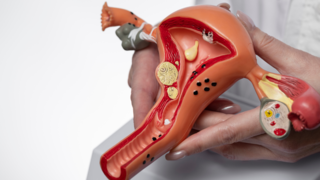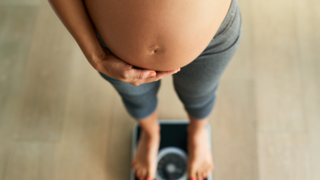In this article:
Understanding its types, key features, benefits, and which bras to avoid will help you pick the right one.
Why You Need Pregnancy Bras During Pregnancy
As your breasts grow and become more sensitive during pregnancy, regular bras can start to feel tight and uncomfortable. Pregnancy bras are designed to address these changes. They give you extra support and flexibility that regular bras don't provide. These bras help ease common issues like back pain, shoulder discomfort, and skin irritation. They let you enjoy your pregnancy without worrying about discomfort.Pregnancy bras are designed with softer fabrics, adjustable straps, and thoughtful features to make sure you feel relaxed and supported throughout this special time.
How Pregnancy Affects Your Breast Size
Hormonal shifts during pregnancy prepare your body for breastfeeding, leading to noticeable changes in your breasts. These changes can begin as early as the first week of pregnancy and continue throughout all trimesters. Below are some of the changes you might experience:- First trimester (weeks 1-12): Breasts may feel sore, tender, or fuller. You might notice slight swelling, larger breast veins, or aching that extends to your armpits.
- Second trimester (weeks 13-26): Breasts grow heavier as milk ducts and colostrum develop. Your ribcage expands, and you may experience occasional leakage.
- Third trimester (weeks 27-42): Breasts grow larger and heavier at a faster rate. Nipples and areolas may enlarge and darken, and you might notice itchiness or dryness due to stretched skin.
- Birth to 3 months postpartum: After birth, breasts continue to enlarge as milk production increases, often peaking around day four when milk “comes in.” Some women may see an increase of one to three cup sizes during pregnancy.
When to Start Wearing a Pregnancy Bra
There’s no set timeline for switching to a pregnancy bra, but most women find their regular bras become uncomfortable by the end of the first trimester or early second trimester.If you notice a snug fit, pressure on your chest, or discomfort, it’s time to make the switch.
Types of Pregnancy Bras
There are different types of pregnancy bras to match your daily needs and routine. Take a look at the options below to find what works best for you.- Pregnancy bras: Offer full coverage and gentle support throughout pregnancy. Wide straps and soft fabrics help you stay comfortable all day.
- Nursing bras: Feature cups that unclip or open easily for breastfeeding, providing support and convenience for feeding.
- Front-open bras: Provide easy access with snap buttons or front closures. Perfect for new moms seeking convenience during nursing.
- Underwire and wireless bras: Underwired bras have a firm wire stitched under each cup to give shape and support. Wireless or soft-cup bras lack this wire and feel gentler on your body.
- Maternity bralettes: Provide light, non-structured support with stretchy fabrics. These are perfect for lounging.
Each type is designed for a specific need. Think about your daily activities and comfort preferences when picking the right one.
Key Features to Look for in a Pregnancy Bra
Choose an adjustable pregnancy bra that adapts to your shape, so you feel secure without constant resizing. Keep these important features in mind when shopping:- Adjustable straps: Allow you to customise the fit as your breasts grow. Straps should not dig into your shoulders and should adjust to your needs.
- Wide bands: Evenly distribute the weight of your breasts. This helps reduce strain on your back and shoulders.
- Soft, breathable fabrics: These materials are gentle on sensitive skin and prevent irritation to keep you comfortable.
- Full coverage: Prevents spillage and provides better support as breasts grow.
- Wire-free design: It helps reduce pressure and improves comfort. This is especially beneficial for extended wear.
- Non-padded options: Offer a natural fit and better airflow to keep you cooler.
- Stretchable cups: Adjust to changes in breast size, especially during the third trimester.
- High-quality elastic bands: Stretch to fit your growing ribcage and keep their shape for long-term use. The band should sit comfortably without cutting into your skin or riding up.
- Drop-down cups: Provide easy access for breastfeeding, making the transition to nursing seamless.
Bras to Avoid During Pregnancy
Not all bras are suitable for pregnancy. Some can cause discomfort or even health problems as your body changes. Avoid the following types of bras during this time:- Regular bras in larger sizes: These lack the stretch and structure needed to support growing breasts and may restrict breast tissue, leading to discomfort.
- Underwire bras: Some experts believe underwire bras may increase the risk of mastitis by restricting milk flow, though evidence is limited.
- Tight or non-adjustable bras: Bras without adjustable straps or bands may become too snug as your rib cage and breasts expand. This can lead to irritation or restricted circulation.
- Synthetic fabrics: Materials like polyester may irritate sensitive skin and cause overheating, unlike breathable options like cotton.
Benefits of Investing in Maternity Bras
Investing in maternity bras that adjust to your body’s changes brings several benefits:- Cost savings: Versatile bras reduce the need for frequent replacements.
- Prevents breast tissue damage: Proper support minimises stretching and stretch marks.
- Improved posture: Eases strain on your back, shoulders, and neck.
- Lower risk of mastitis: Wireless designs promote better milk flow and reduce the risk of blocked ducts.
- Improved comfort: Stretchy, high-quality fabrics adjust to breast growth and shrinkage without sacrificing support.
Why Invest in Multiple Pregnancy Bras
Having several pregnancy bras is practical and beneficial for your comfort. Take a look at why you should consider owning more than one:- Hygiene: Rotating bras prevents sweat buildup and ensures you always have a fresh, clean option.
- Comfort variety: Different styles, such as sleep or wireless bras, provide support for varying sensitivity levels and daily needs.
- Durability: Alternating bras reduce wear and tear, extending their lifespan.
FAQs on How To Choose an Ideal Bra for Pregnancy
- When should I start wearing a pregnancy bra?
It’s best to switch when your regular bras become uncomfortable. This typically happens by the end of the first trimester or early second trimester. - Why is an underwire bra not recommended during pregnancy?
Underwires can dig into sensitive breast tissue and restrict milk flow, increasing the risk of mastitis. - Can pregnancy bras help with back pain?
Yes, well-fitted pregnancy bras with wide bands and proper support can help reduce back and shoulder pain.









